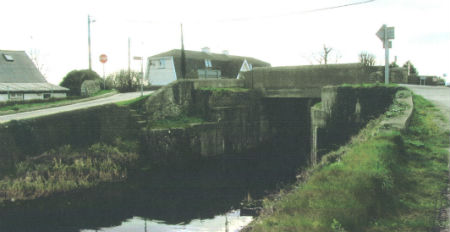|
<< Back to the main Local History page
By Domhnall O Muirí
As one drives towards Newcastle across the bridge at the 12th Lock, it is hard to believe that a busy but short-lived little narrow gauge railway once crossed the canal at the same location and hugged the side of the road almost to the junction where Polly Hops once stood. Whilst the so-called Great War still raged over Western Europe another prediction of the great science fiction writer H.G. Wells had come true – war in the air. Rapid developments since the fledgling flight of the Wright brothers 1903 had seen the aeroplane develop into a military machine capable of sustained flight, facilitating hitherto impossible observation of the battlefields, intelligence gathering and of course ground and aerial attack. Naturally these new machines needed places to operate from, and with the rapid increase in numbers of aircraft came the requirement for a substantial number of airfields.
Although the island of Ireland was not in the conflict zone, it was a colony of strategic importance and perhaps with some foresight of another conflict that was shortly to come, the British occupation forces embarked upon the construction of a number of airfields around the island, including one at Baldonnel, which is still in operation today with Aer Chór na hÉireann. In 1917 when construction of Baldonnell Aerodrome began, the nearest mainline railway station was the Great Southern and Western’s Lucan South station, the site of which was adjacent to the Newcastle Road overbridge. At Lucan South an additional siding was laid, alongside which two narrow gauge (24” gauge) sidings were also laid. From this point the narrow gauge railway, similar in type to the vast network of trench railways on the Western Front, continued across the fields, crossing the canal at the 12th lock on a metal girder bridge, the concrete abutments of which are still clearly visible today. From the canal the railway followed the road towards Milltown for a distance, then veered off into the fields before crossing the Clondalkin-Newcastle Road. From there onwards it followed the road to Baldonnell.

A photo montage illustrating how the bridge and workmen’s train at the 12th lock would have appeared in 1918. (Domhnall Ó Muirí).
Two steam locomotives worked the line, which carried both the workmen and the construction materials required for the aerodrome. Every morning a special train would arrive at Lucan South from Kingsbridge (now Heuston), and two narrow gauge trains would convey up to 200 workmen each on up to 25 open wagons with back-to-back seats. Waiting lorries would convey anyone who could not be accommodated on the trains.

The workmen’s trains would return at approximately 17:30 and again at 19:30 for those working overtime. The trains as previously noted also carried the construction materials, including sand, gravel, timber and asbestos sheeting, all of which were transhipped from the mainline trains by hand at Lucan South. Supplies for the canteens were also carried. The number of troops stationed at Baldonnell occasionally reached the 1700 mark and at times included American and Canadian soldiers.
The busy little railway remained in use for approximately two years until construction was complete and the two little steam locomotives were later sent to India. Today, the only visible evidence that the railway ever existed are the concrete abutments that once carried the metal girder bridge at the eastern side of the present day road bridge.

The bridge at the 12th lock as it is in 2013. The concrete abutments that once carried the narrow gauge railway’s metal girder bridge are still clearly visible. (Domhnall O Muirí)
www.donalmurray.co
|

